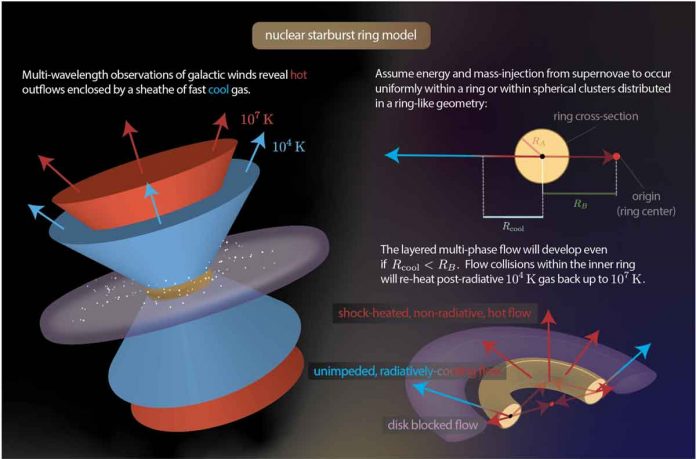Galactic superwinds, which are large outflows of gas caused by a combination of supernova explosions and stellar winds, are intimately linked to the early stages of a galaxy’s development and evolution, including aspects such as its size, shape, and even how many stars will eventually call it home.
However, while researchers have frequently observed these winds, little is known about the mechanism that drives them. Astronomers have long suspected that galactic winds are propelled by nuclear star-forming rings, which form in space and contain a large number of stars. Researchers were able to construct three-dimensional simulations that uniquely predict the observed morphology of these superwinds in a new paper published in The Astrophysical Journal Letters.
According to Dustin Nguyen, lead author of the paper and a graduate student in physics at The Ohio State University, their work demonstrates that understanding galactic evolution requires understanding the underlying geometric assumptions of where stars release energy. Their research discovered that starburst rings, rather than spheres, produce outflows more akin to those seen in nature.
“Since galaxies’ star-forming cores are observed to be non-spherical, we should model them accordingly,” Nguyen said.
It was also previously assumed that black holes were primarily responsible for the occurrence of massive X-ray bubbles, as evidence shows that they exist above and below the disc of the Milky Way. However, the study shows that nuclear star-forming rings can produce qualitatively similar structures. This could be significant because the Milky Way has a ring-like structure known as the Central Molecular Zone.
The simulations were created using data generated by Cholla, an open-source computer code that has been run on some of the world’s largest supercomputers, including those at the Ohio Supercomputer Center, where the model was created.
“This kind of computing would have been impossible thirty years ago, but we’re no longer limited by technology,” Nguyen said. “We can now study more complicated structures by conducting high-resolution numerical experiments with parallel-optimized code.”
While their findings have long-term implications for X-ray astronomy—a branch of science that studies celestial objects by detecting high levels of X-ray radiation they emit—Nguyen explained that his model is easier to design than previous models. Nguyen chose to ignore the additional physics of forces like gravity and magnetic fields when designing the parameters of their simulation but was still able to generate a model of how a galactic wind operates.
Nguyen intends to recreate the simulations in the future, but with variables that account for more complicated physics.
“The model reproduces a lot of the key features in galactic winds, which speaks to the efficacy of our work,” Nguyen said. “However, the next step is to incorporate those additional physics and see what happens.”

